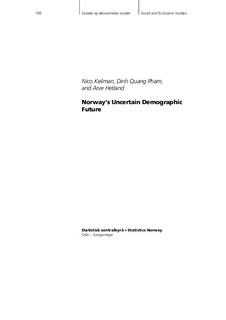| dc.description.abstract | The demographic future of any population is uncertain, but some of the many
possible trajectories are more probable than others. Therefore, an exploration of
the demographic future should include two elements: a range of possible
outcomes, and a probability attached to that range. Together, these two constitute
a prediction interval for the population variable concerned. This report presents the
findings of a research project, the aim of which was to compute prediction
intervals for the future population of Norway broken down by age and sex to the
horizon 2050.
We estimate that the odds are four against one (80 per cent chance) that Norway’s
population, now 4.5 million, will number between 4.3 and 5.4 million in the year
2025, and 3.7-6.4 million in 2050. This illustrates that uncertainty increases with
time. There is a clear trade-off between greater accuracy (higher odds) and higher
precision (narrower intervals). Odds of 19 against one (95 per cent chance) result in
a wider interval: 4.1-5.7 million in 2025, and 3.2-7.3 million in 2050. The
probabilistic population forecasts of the youngest and the oldest age groups show
largest uncertainty, because fertility and mortality are hard to predict. As a result,
prediction intervals in 2030 for the population younger than 20 years are so wide,
that the forecast is not very informative. International migration shows large
prediction intervals around expected levels, but its impact on the age structure is
modest. In 2050, uncertainty has cumulated so strongly, that intervals are very
large for virtually all age groups, in particular when the intervals are judged in a
relative sense (compared to the median forecast). According to our statistical
model, the expected accuracy of the total population size forecast published by
Statistics Norway is somewhat below two-thirds on the long run, and a little above
that level on the short run.
The results have been obtained on the basis of stochastic simulation of each of the
three components of population change; fertility, mortality, and international
migration. Simulation of the components relied heavily on three complementary methods: time series analysis for the historical development of key demographic
indicators, such as the TFR, the life expectancy, and numbers of immigrants and
emigrants;an analysis of historical forecast errors, assembled on the basis of forecasts
produced by Statistics Norway since 1969;and finally expert judgement, which was used, for instance, to restrict the
prediction interval for the TFR or that for the numbers of immigrants and
emigrants to a reasonable range. The predictions for each component were calibrated in such a way that the median
coincided with the Medium Variant value of the 1999-based official population
forecast of Statistics Norway.
The time series predictions indicated that assumptions on future TFR as employed
by Statistics Norway in its official population forecasts have estimated coverage
probabilities of only 46, 31, and 24 per cent in the years 2010, 2030, and 2050.
The official mortality (i.e. life expectancy) assumptions have higher expected
accuracy in 2050 (just over 60 per cent), but lower accuracy in the beginning of
this century (just over a third in the period 2000-2010). | en_US |
